Biotope Area Factor: An Ecological Urban Index to Geovisualize Soil Sealing in Padua, Italy
Abstract
1. Soil Sealing in Europe and Italy
2. Materials and Methods
2.1. Case Study: Soil Sealing in Padua
2.2. The Biotope Area Factor (BAF)
2.3. Simulated Mitigation Scenario
3. Results and Discussion
3.1. Land Use Analysis
3.2. BAF Analysis
3.3. Hexagon Mosaic Map for Soil Sealing Geovisualization
3.4. Mitigation Scenario: Rooftop Greening
3.5. Towards More Sustainable Cities: BAF as Tool for Urban Planning
5. Conclusions
Author Contributions
Funding
Acknowledgments
Conflicts of Interest
References
- Prokop, G.; Jobstmann, H.; Schönbauer, A. Report on Best Practices for Limiting Soil Sealing and Mitigating Its Effects; European Commission: Brussels, Belgium, 2011. [Google Scholar]
- Naumann, S.; Frelih-Larsen, A.; Prokop, G.; Ittner, S.; Reed, M.; Mills, J.; Morari, F.; Verzandvoort, S.; Albrecht, S.; Bjuréus, A.; et al. Land Take and Soil Sealing—Drivers, Trends and Policy (Legal) Instruments: Insights from European Cities. In International Yearbook of Soil Law and Policy 2018; Ginzky, H., Dooley, E., Heuser, I.L., Kasimbazi, E., Markus, T., Qin, T., Eds.; Springer: Cham, Switzerland, 2019; pp. 83–112. [Google Scholar]
- Artmann, M.; Breuste, J. Cities Built for and by Residents: Soil Sealing Management in the Eyes of Urban Dwellers in Germany. J. Urban Plan. Dev. 2015, 141, A5014004. [Google Scholar] [CrossRef]
- European Commission. Science for Environment Policy. In Soil Sealing; European Commission: Brussels, Belgium, 2012; pp. 1–41. [Google Scholar]
- Seto, K.C.; Fragkias, M.; Güneralp, B.; Reilly, M.K. A Meta-Analysis of Global Urban Land Expansion. PLoS ONE 2011, 6, e23777. [Google Scholar] [CrossRef] [PubMed]
- Soil-Soil Sealing. Available online: https://ec.europa.eu/environment/soil/sealing_guidelines.htm (accessed on 5 November 2019).
- Commission of the European Communities. Towards a Thematic Strategy for Soil Protection; CEC: Brussels, Belgium, 2002. [Google Scholar]
- Gardi, C. Urban Expansion, Land Cover and Soil Ecosystem Services, 1st ed.; Gardi, C., Ed.; Routledge: New York, NY, USA, 2017; ISBN 9781317504719. [Google Scholar]
- Scalenghe, R.; Marsan, F.A. The anthropogenic sealing of soils in urban areas. Landsc. Urban Plan. 2009, 90, 1–10. [Google Scholar] [CrossRef]
- Wessolek, G. Sealing of soils. In Urban Ecology: An International Perspective on the Interaction Between Humans and Nature; Marzluff, J.M., Shulenberger, E., Endlicher, W., Alberti, M., Bradley, G., Ryan, C., Simon, U., ZumBrunnen, C., Eds.; Springer: New York, NY, USA, 2008; pp. 161–179. [Google Scholar]
- Siebielec, G.; Lazar, S.; Kaufmann, C.; Jaensch, S. Handbook for Measures Enhancing Soil Function Performance and Compensating Soil Loss during Urbanization Process; Urban SMS project: Stuttgart, Germany, 2010. [Google Scholar]
- Opolot, E.; Yu, Y.Y.; Finke, P.A. Modeling soil genesis at pedon and landscape scales: Achievements and problems. Quat. Int. 2015, 376, 34–46. [Google Scholar] [CrossRef]
- Tobias, S.; Conen, F.; Duss, A.; Wenzel, L.M.; Buser, C.; Alewell, C. Soil sealing and unsealing: State of the art and examples. Land Degrad. Dev. 2018, 29, 2015–2024. [Google Scholar] [CrossRef]
- Aksoy, E.; Gregor, M.; Schröder, C.; Löhnertz, M.; Louwagie, G. Assessing and analysing the impact of land take pressures on arable land. Solid Earth 2017, 8, 683–695. [Google Scholar] [CrossRef]
- Ceccarelli, T.; Bajocco, S.; Salvati, L.; Perini, L. Investigating syndromes of agricultural land degradation through past trajectories and future scenarios. Soil Sci. Plant Nutr. 2014, 60, 60–70. [Google Scholar] [CrossRef]
- Stankovics, P.; Tóth, G.; Tóth, Z.; Stankovics, P.; Tóth, G.; Tóth, Z. Identifying Gaps between the Legislative Tools of Soil Protection in the EU Member States for a Common European Soil Protection Legislation. Sustainability 2018, 10, 2886. [Google Scholar] [CrossRef]
- Paleari, S. Is the European Union protecting soil? A critical analysis of Community environmental policy and law. Land Use Policy 2017, 64, 163–173. [Google Scholar] [CrossRef]
- Ronchi, S.; Salata, S.; Arcidiacono, A.; Piroli, E.; Montanarella, L. Policy instruments for soil protection among the EU member states: A comparative analysis. Land Use Policy 2019, 82, 763–780. [Google Scholar] [CrossRef]
- EU Parliament; EU Council. General Union Environment Action Programme to 2020 Living Well, Within the Limits of Our Planet; Publications Office if the European Union: Luxembourg, 2013; pp. 171–200. [Google Scholar]
- Decoville, A.; Schneider, M. Can the 2050 zero land take objective of the EU be reliably monitored? A comparative study. J. Land Use Sci. 2016, 11, 331–349. [Google Scholar] [CrossRef]
- Regione del Veneto. Disposizioni per il contenimento del consumo di suolo e modifiche della legge regionale 23 aprile 2004, n. 11. In Norme Per Il Governo Del Territorio e in Materia di Paesaggio; Regione del Veneto: Venezia, Italia, 2017; pp. 1–22. [Google Scholar]
- European Commission. Guidelines on Best Practice to Limit, Soil Sealing Mitigate or Compensate; EC: Brussels, Belgium, 2012. [Google Scholar]
- Rodríguez-Rojas, M.I.; Huertas-Fernández, F.; Moreno, B.; Martínez, G.; Grindlay, A.L. A study of the application of permeable pavements as a sustainable technique for the mitigation of soil sealing in cities: A case study in the south of Spain. J. Environ. Manag. 2018, 205, 151–162. [Google Scholar] [CrossRef] [PubMed]
- Buccola, N.; Spolek, G. A Pilot-Scale Evaluation of Greenroof Runoff Retention, Detention, and Quality. Water Air Soil Pollut. 2011, 216, 83–92. [Google Scholar] [CrossRef]
- Alexandri, E.; Jones, P. Temperature decreases in an urban canyon due to green walls and green roofs in diverse climates. Build. Environ. 2008, 43, 480–493. [Google Scholar] [CrossRef]
- Oberndorfer, E.; Lundholm, J.; Bass, B.; Coffman, R.R.; Doshi, H.; Dunnett, N.; Gaffin, S.; Köhler, M.; Liu, K.K.Y.; Rowe, B. Green Roofs as Urban Ecosystems: Ecological Structures, Functions, and Services. Bioscience 2007, 57, 823–833. [Google Scholar] [CrossRef]
- Sinha, P.; Verma, N.K.; Ayele, E. Urban Built-up Area Extraction and Change Detection of Adama Municipal Area using Time-Series Landsat Images. Int. J. Adv. Remote Sens. GIS 2016, 5, 1886–1895. [Google Scholar] [CrossRef]
- Hung, C.-L.J.; James, L.A.; Hodgson, M.E. An automated algorithm for mapping building impervious areas from airborne LiDAR point-cloud data for flood hydrology. GISci. Remote Sens. 2018, 55, 793–816. [Google Scholar] [CrossRef]
- Behnisch, M.; Poglitsch, H.; Krüger, T.; Behnisch, M.; Poglitsch, H.; Krüger, T. Soil Sealing and the Complex Bundle of Influential Factors: Germany as a Case Study. ISPRS Int. J. Geo-Inf. 2016, 5, 132. [Google Scholar] [CrossRef]
- Huete, A.R. A soil-adjusted vegetation index (SAVI). Remote Sens. Environ. 1988, 25, 295–309. [Google Scholar] [CrossRef]
- Congedo, L.; Sallustio, L.; Munafò, M.; Ottaviano, M.; Tonti, D.; Marchetti, M. Copernicus high-resolution layers for land cover classification in Italy. J. Maps 2016, 12, 1195–1205. [Google Scholar] [CrossRef]
- De Lotto, R.; Casella, V.; Franzini, M.; Gazzola, V.; Morelli di Popolo, C.; Sturla, S.; Venco, E.M. Estimating the Biotope Area Factor (BAF) by Means of Existing Digital Maps and GIS Technology. In Computational Science and Its Applications—ICCSA 2015; Gervasi, O., Murgante, B., Misra, S., Gavriloca, M.L., Alves Coutinho Rocha, A.M., Torre, C., Taniar, D., Apduhan, B.O., Eds.; Springer International Publishing AG Switzerland: Basel, Switzerland, 2015; pp. 617–632. ISBN 9783319214696. [Google Scholar]
- European Environment Agency. Copernicus Land Monitoring Service—High Resolution Layer Imperviousness: Product Specifications Document; Copernicus Team at EEA: Copenhagen, Denmark, 2018. [Google Scholar]
- ISPRA. Consumo di Suolo, Dinamiche Territoriali e Servizi Ecosistemici. Edizione 2018, 1st ed.; Munafò, M., Ed.; ISPRA: Roma, Italia, 2018; ISBN 9788844809027. [Google Scholar]
- ISPRA. Consumo di Suolo. Dinamiche Territoriali e Servizi Ecosistemici. Edizione 2019, 1st ed.; Michele, M., Ed.; ISPRA: Roma, Italia, 2019; ISBN 9788844807764. [Google Scholar]
- ASC-Atlante Statistico dei Comuni. Available online: http://asc.istat.it/asc_BL/ (accessed on 2 November 2019).
- Comune di Padova. Padova, Città D’acque. Un Modo Diverso Per Conoscere La Città; Ufficio Turismo Settore Comunicazioni ai Cittadini: Padova, Italy, 2004. [Google Scholar]
- Gullino, G. Storia Di Padova. Dall’antichità All’età Contemporanea; Gullino, G., Ed.; Cierre Edizioni: Verona, Italy, 2009; ISBN 978-8883145292. [Google Scholar]
- Marzari, S. Padova e la città metropolitana. In 1807–2007 La Metamorfosi Del Paesaggio Urbano; Marzari, S., Ed.; I Antichi Editori: Venezia, Italia, 2008. [Google Scholar]
- Berlin Biotope Area of Factor-Implementation Guidelines Helping to Control Temperature and Runoff-Climate Adapt. Available online: https://climate-adapt.eea.europa.eu/metadata/case-studies/berlin-biotope-area-factor-2013-implementation-of-guidelines-helping-to-control-temperature-and-runoff/#challenges_anchor (accessed on 5 November 2019).
- Ahern, J. Green infrastructure for cities: The spatial dimension. In Cities of the Future: Towards Integrated Sustainable Water and Landscape Management; Novotny, V., Brown, P., Eds.; IWA Publishing: London, UK, 2007; pp. 267–283. [Google Scholar]
- Keeley, M. The Green Area Ratio: An urban site sustainability metric. J. Environ. Plan. Manag. 2011, 54, 937–958. [Google Scholar] [CrossRef]
- Ingegnoli, V. Landscape Bionomics Biological-Integrated Landscape Ecology; Springer: Milan, Italy, 2015; ISBN 9788847052253. [Google Scholar]
- Becker, G.; Mohren, R. The Biotope Area Factor as an Ecological Parameter; Landschaft: Planen & Bauen: Berlin, Germany, 1990. [Google Scholar]
- Lakes, T.; Kim, H.O. The urban environmental indicator biotope Area Ratio-An enhanced approach to assess and manage the urban ecosystem services using high resolution remote-sensing. Ecol. Indic. 2012, 13, 93–103. [Google Scholar] [CrossRef]
- Casella, V.; Franzini, M.; De Lotto, R. Geomatics for smart cities: Obtaining the urban planning BAF index from existing digital maps. In Proceedings of the International Archives of the Photogrammetry, Remote Sensing and Spatial Information Sciences, Prague, Czech Republic, 12–19 July 2016; pp. 689–694. [Google Scholar]
- Birch, C.P.D.; Oom, S.P.; Beecham, J.A. Rectangular and hexagonal grids used for observation, experiment and simulation in ecology. Ecol. Model. 2007, 206, 347–359. [Google Scholar] [CrossRef]
- Carr, D.B.; Olsen, A.R.; White, D. Hexagon Mosaic Maps for Display of Univariate and Bivariate Geographical Data. Cartogr. Geogr. Inf. Syst. 1992, 19, 228–236. [Google Scholar] [CrossRef]
- Goldblatt, R.; Stuhlmacher, M.F.; Tellman, B.; Clinton, N.; Hanson, G.; Georgescu, M.; Wang, C.; Serrano-Candela, F.; Khandelwal, A.K.; Cheng, W.H.; et al. Using Landsat and nighttime lights for supervised pixel-based image classification of urban land cover. Remote Sens. Environ. 2018, 205, 253–275. [Google Scholar] [CrossRef]
- Berndtsson, C.J. Green roof performance towards management of runoff water quantity and quality: A review. Ecol. Eng. 2010, 36, 351–360. [Google Scholar] [CrossRef]
- Rowe, D.B.; Getter, K.L. The role of extensive green roofs in sustainable development. HortScience 2006, 41, 1276–1285. [Google Scholar]
- De Lotto, E.M. Venco Efficacia e Attuabilità di Indici Ecologico Ambientali nella Pratica Urbanistica. In Proceedings of the XXVIII Congresso dell’INU: Il governo della città nella contemporaneità, Salerno, Italia, 24–26 October 2015; Sbetti, E.M., Rossi, E.M., Talia, E.M., Trillo, E.M., Eds.; La Città Come Motore Di Sviluppo. INU Edizioni: Salerno, Italia, 2015. [Google Scholar]
- Centro di Ricerca sui Consumi di Suolo. CRCS 2018: Consumo Di Suolo, Servizi Ecosistemici E Green Infrastructures; Arcidiacono, A., Di Simine, D., Ronchi, S., Salata, S., Eds.; INU Edizioni: Roma, Italy, 2018; ISBN 9788876031854. [Google Scholar]
- Gao, Y.; Wang, D.; Schmidt, A.; Tang, Y. Exploring the Response of Combined Urban Sewer System to the Implementation of Green Roof. In The 4th International Conference on Environmental Systems Research; IOP Publishing Ltd: Bristol, UK, 2017; pp. 1–7. [Google Scholar]
- Köhler, M.; Schmidt, M.; Grimme, F.W.; Laar, M.; Gusmão, F. Urban Water Retention by Greened Roofs in Temperate and Tropical Climate. In Proceedings of the 38th IFLA World Congress International Federation of Landscape Architects, Singapore, 26–29 June 2001; pp. 151–162. [Google Scholar]
- Artmann, M. Urban gray vs. urban green vs. soil protection—Development of a systemic solution to soil sealing management on the example of Germany. Environ. Impact Assess. Rev. 2016, 59, 27–42. [Google Scholar] [CrossRef]
- Artmann, M. Managing urban soil sealing in Munich and Leipzig Germany-From a wicked problem to clumsy solutions. Land Use Policy 2015, 46, 21–37. [Google Scholar] [CrossRef]
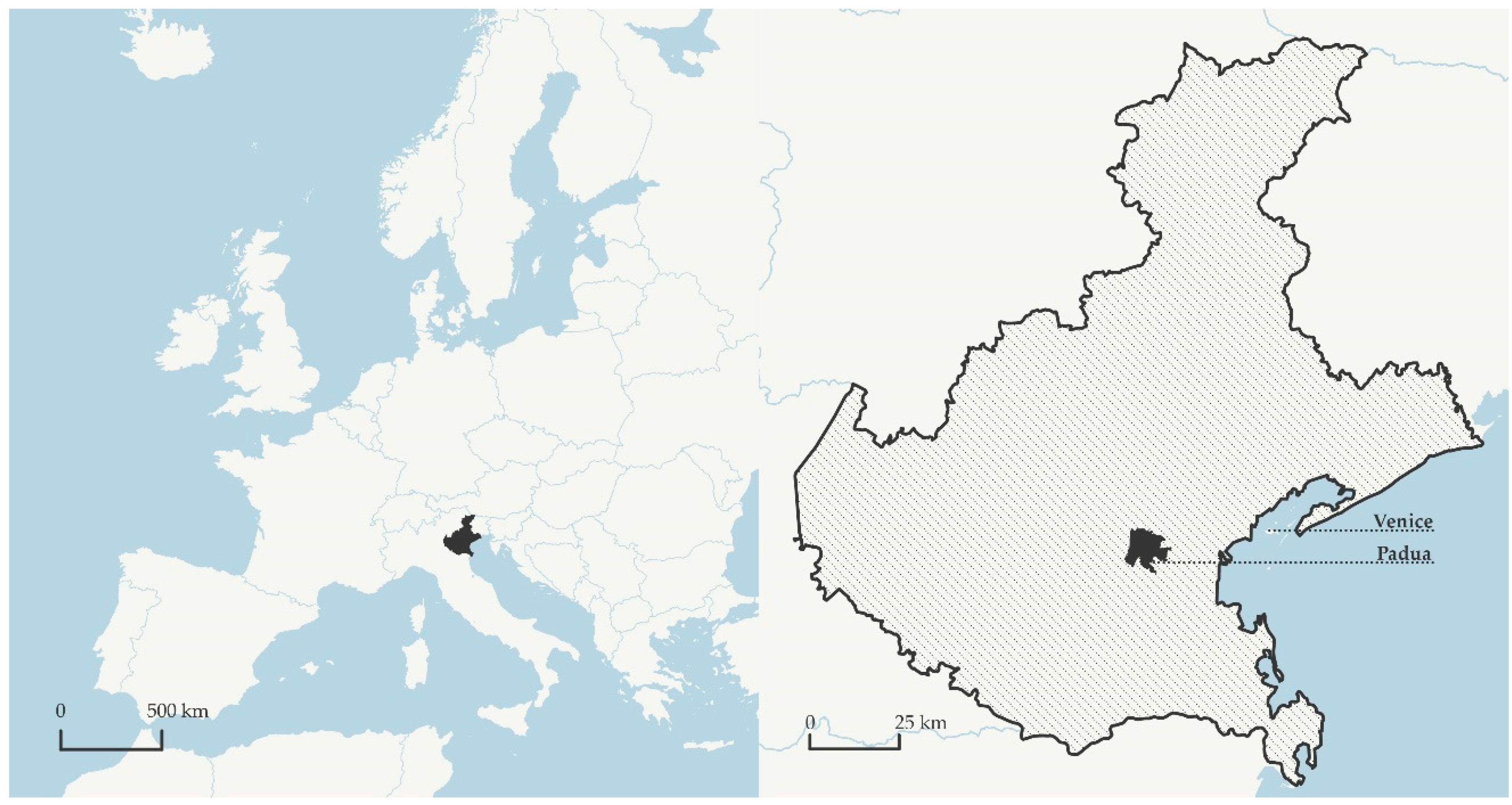
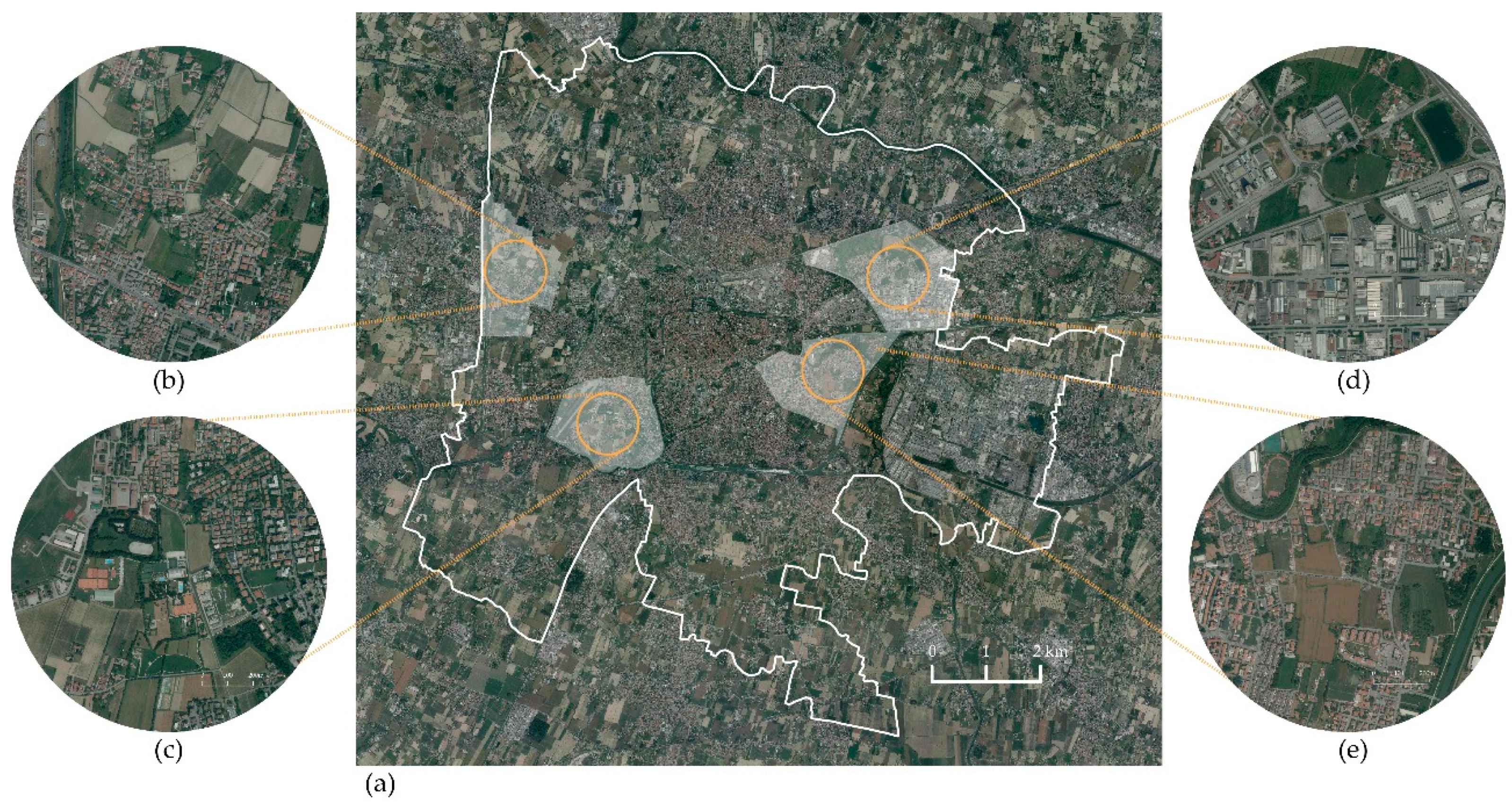
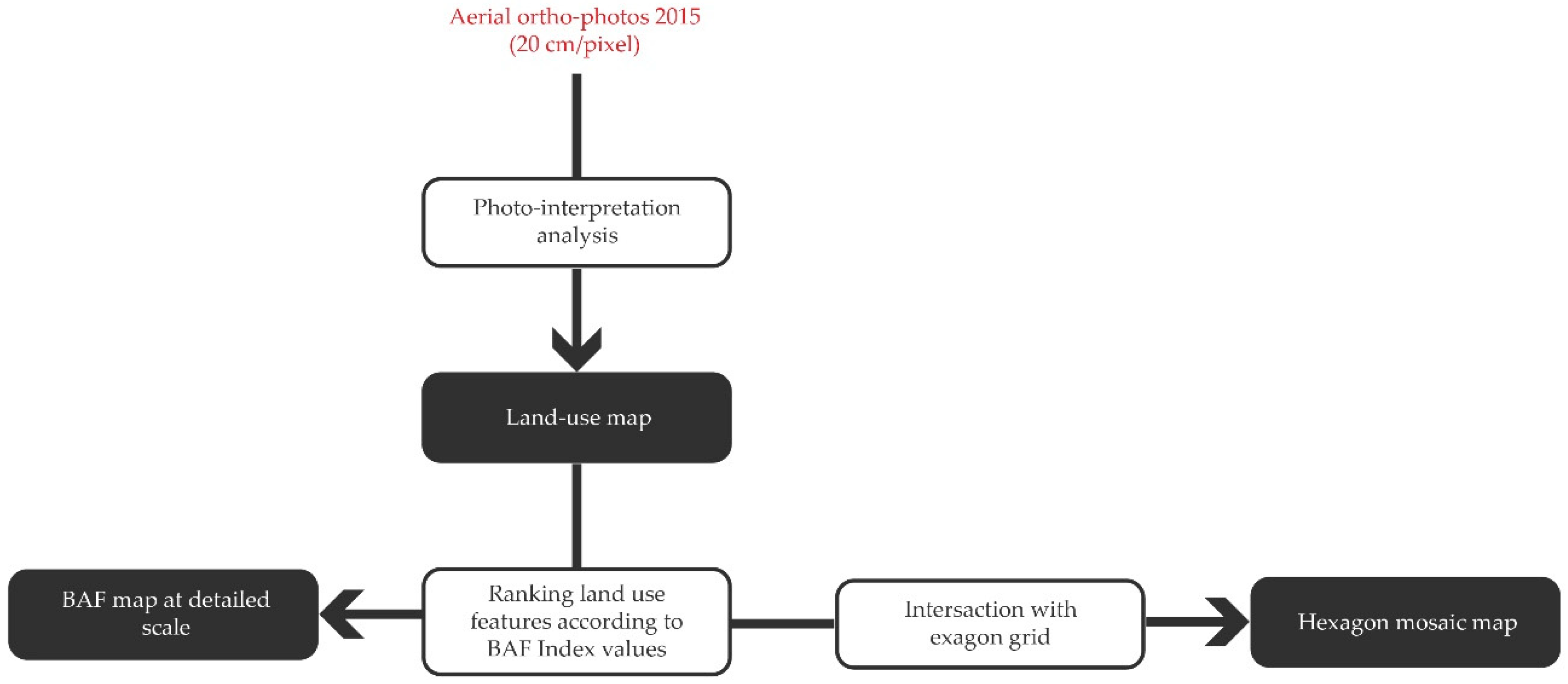
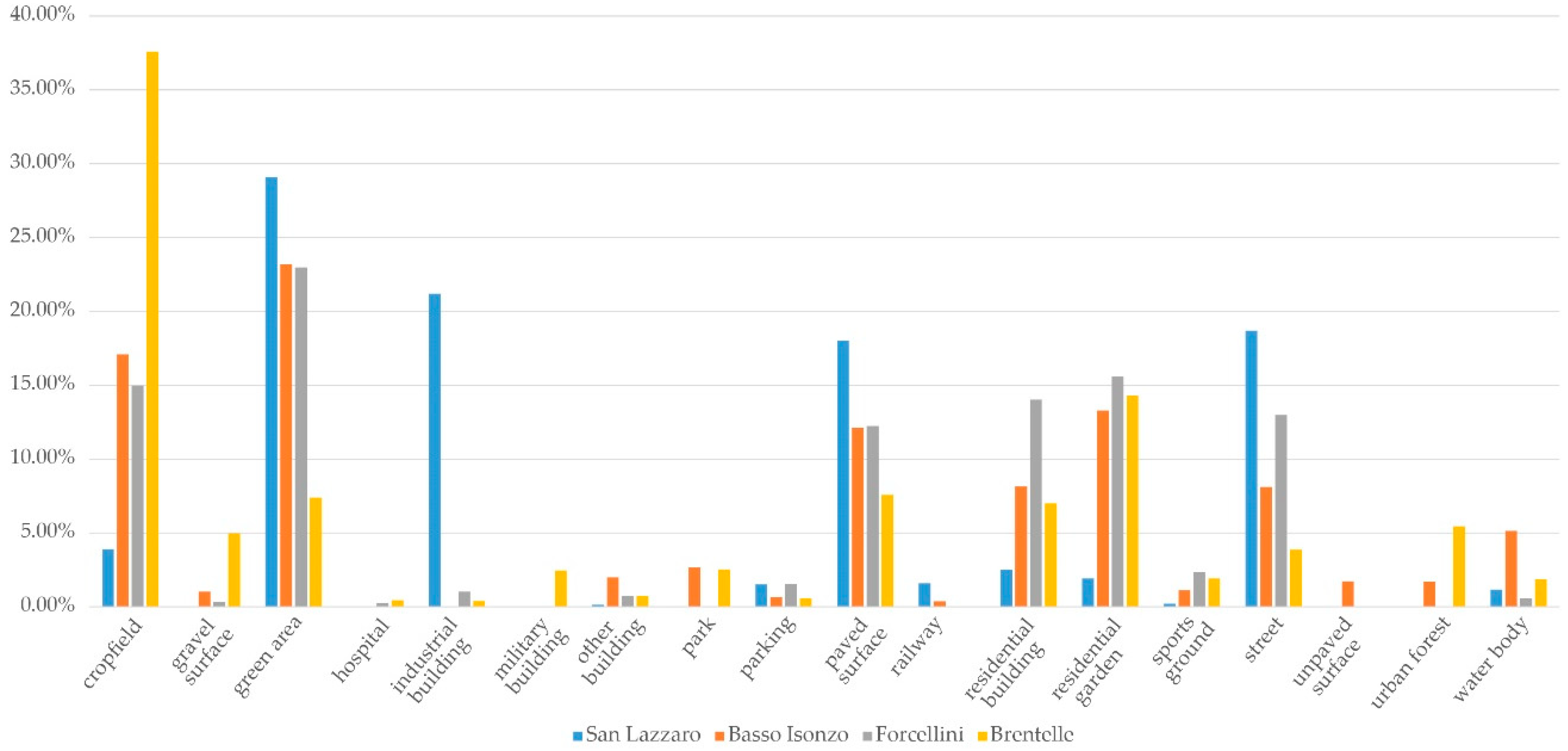
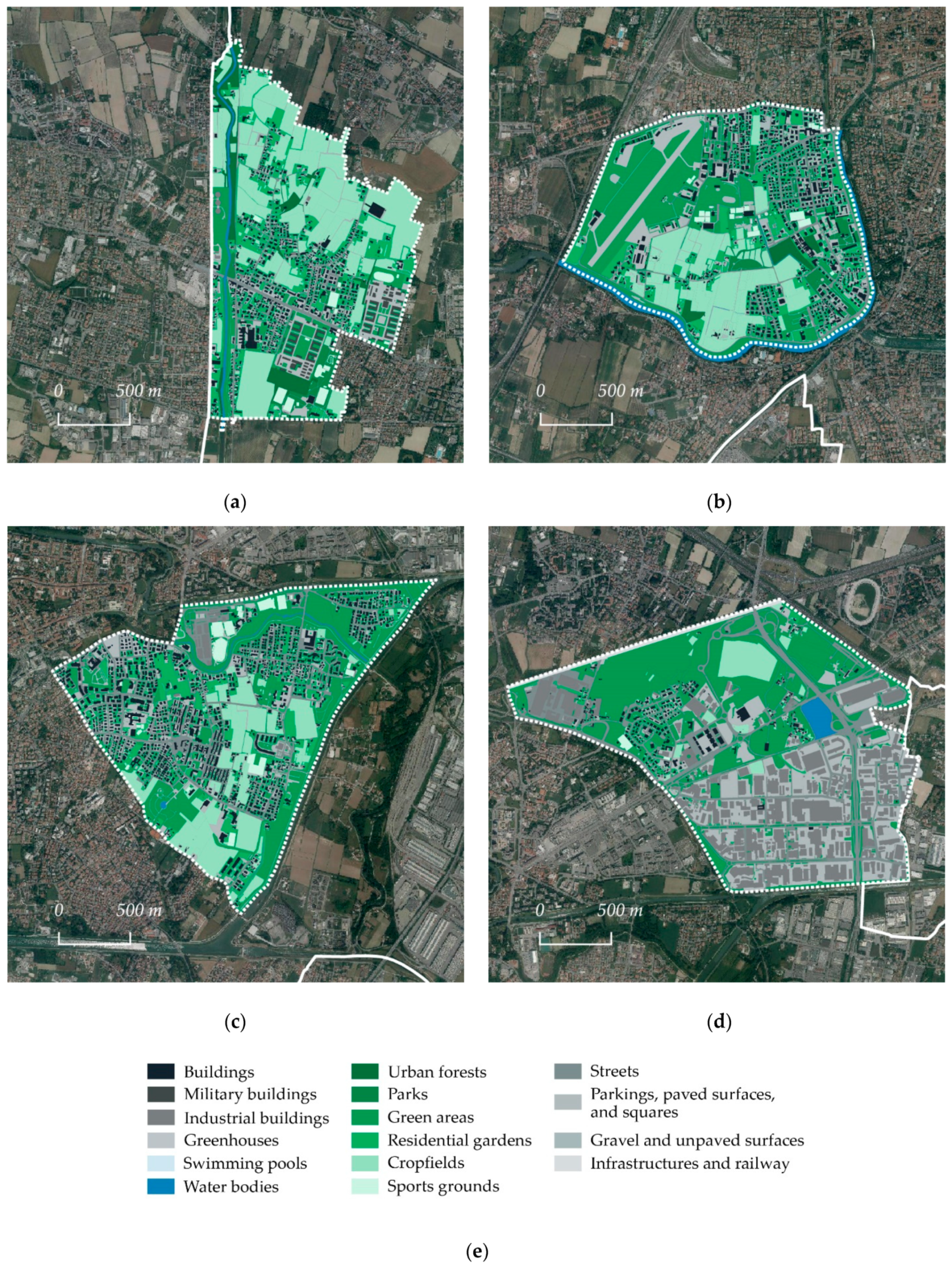
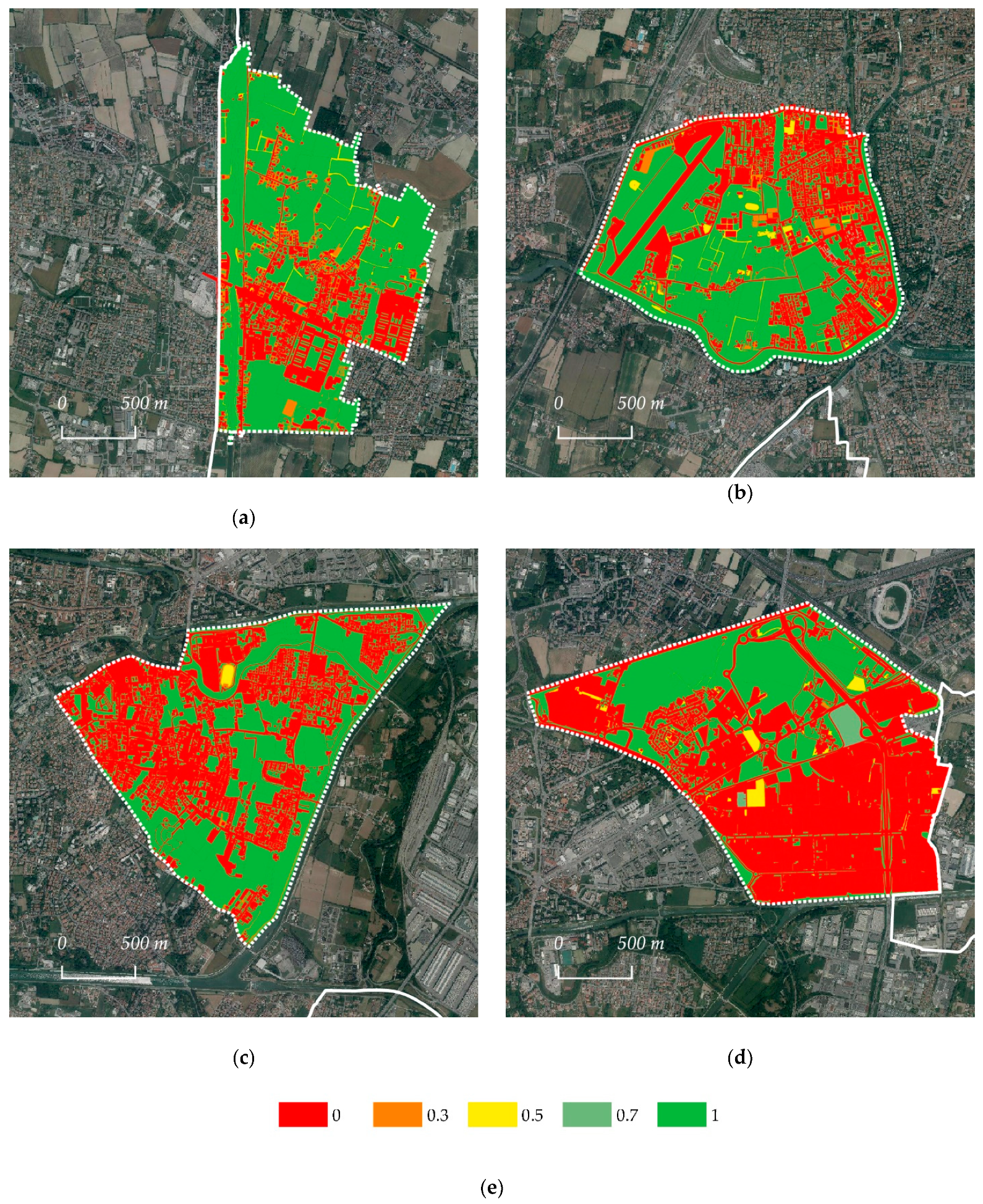
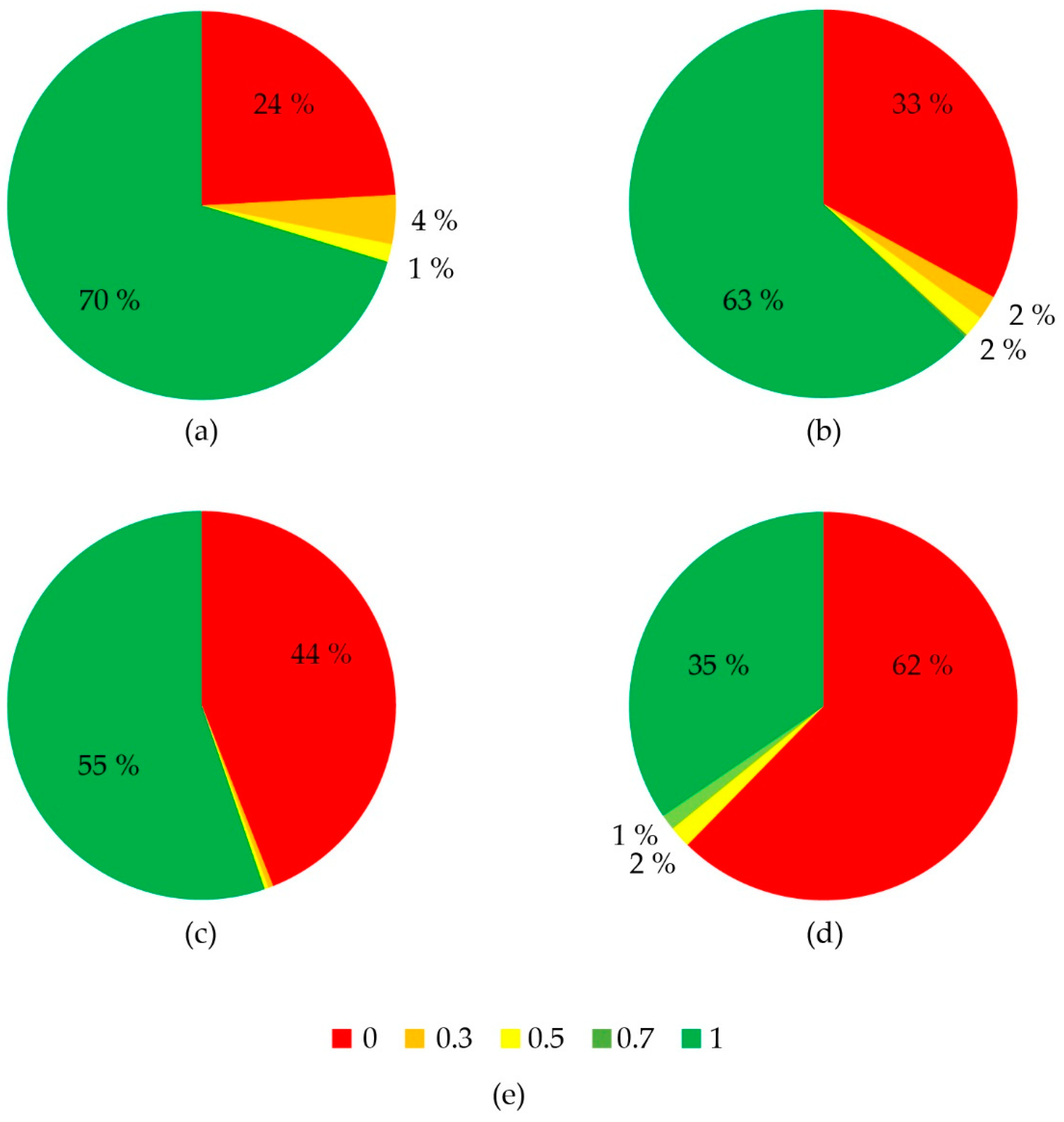
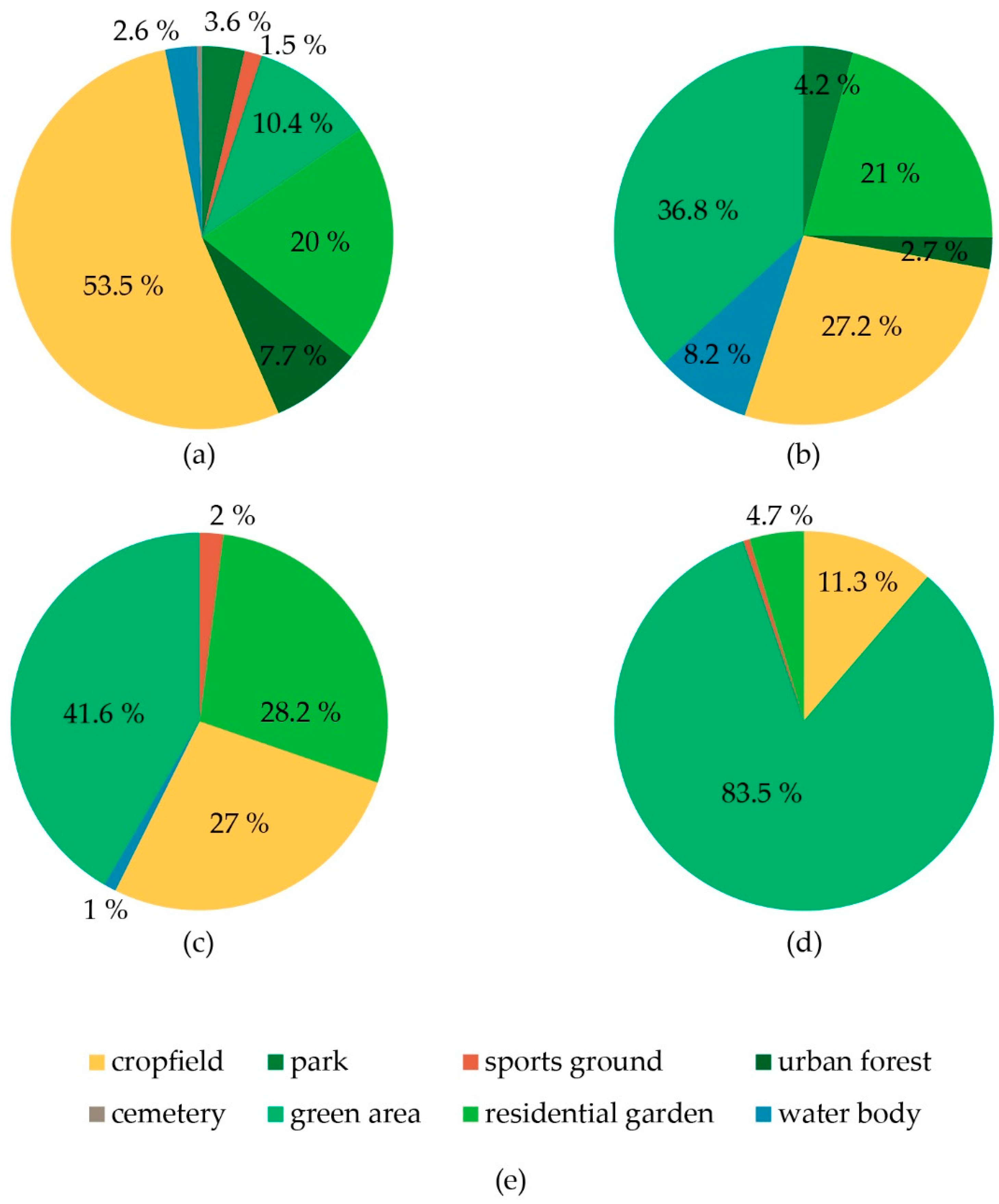
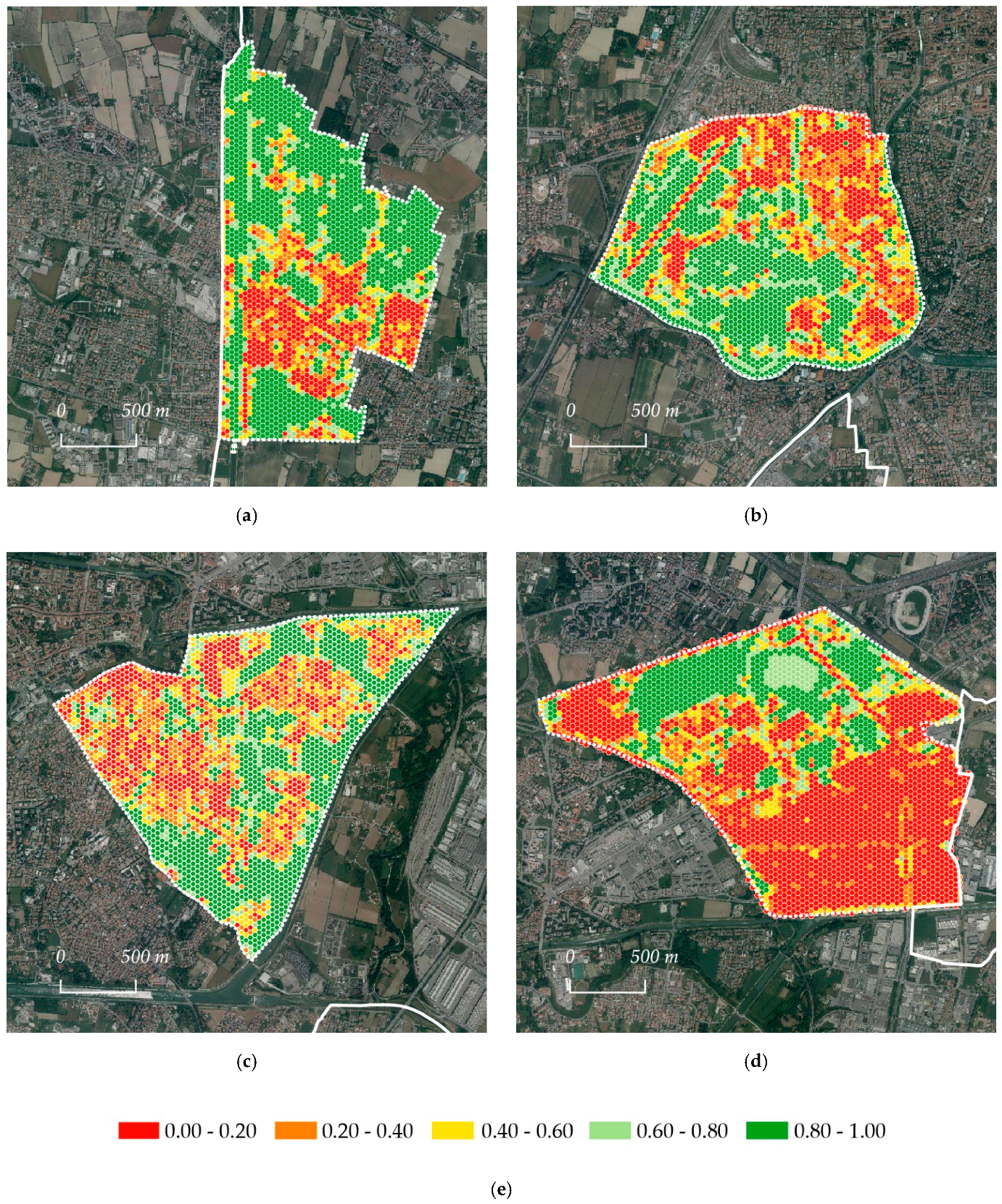
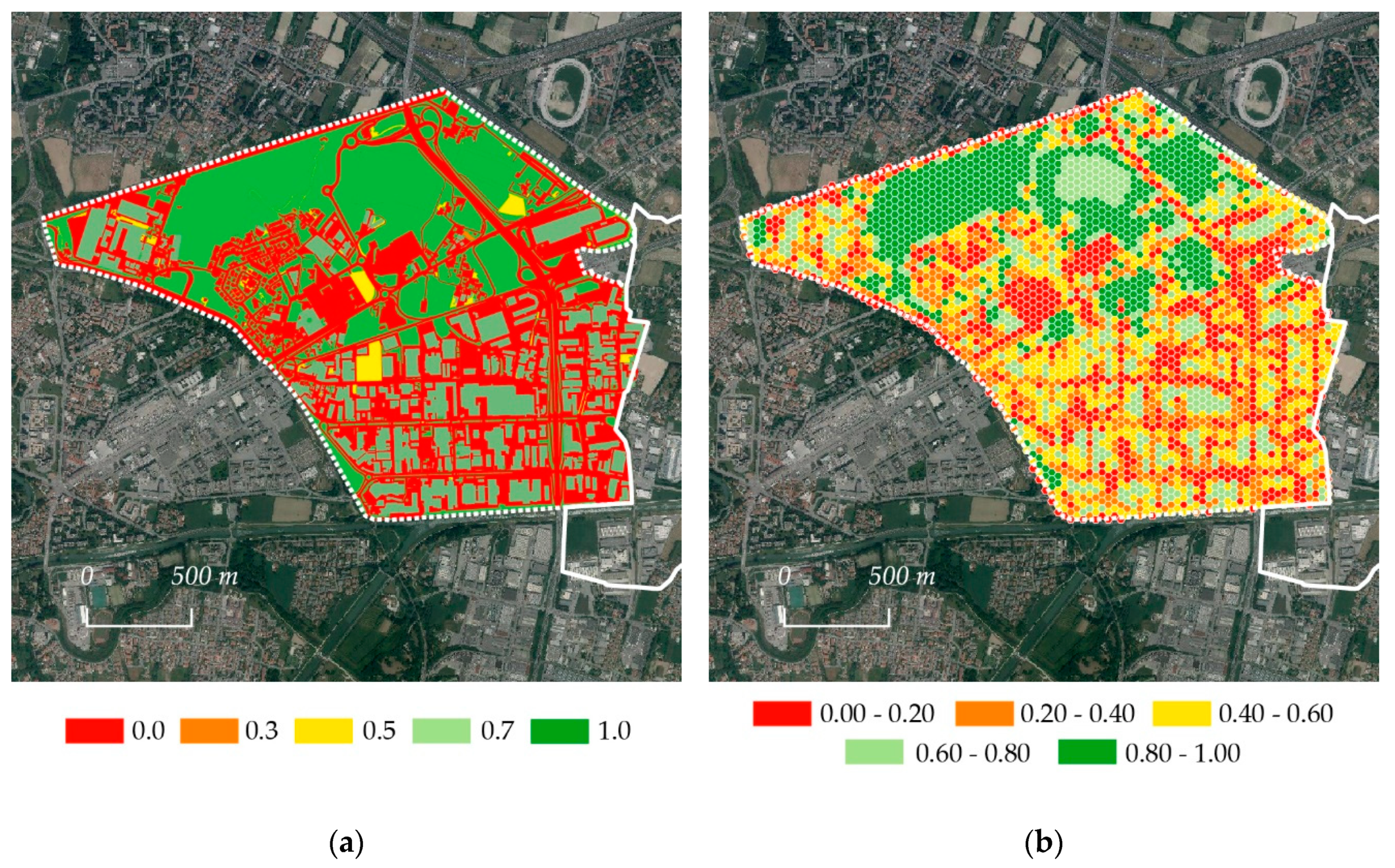
© 2019 by the authors. Licensee MDPI, Basel, Switzerland. This article is an open access article distributed under the terms and conditions of the Creative Commons Attribution (CC BY) license (http://creativecommons.org/licenses/by/4.0/).
Share and Cite
Peroni, F.; Pristeri, G.; Codato, D.; Pappalardo, S.E.; De Marchi, M. Biotope Area Factor: An Ecological Urban Index to Geovisualize Soil Sealing in Padua, Italy. Sustainability 2020, 12, 150. https://doi.org/10.3390/su12010150
Peroni F, Pristeri G, Codato D, Pappalardo SE, De Marchi M. Biotope Area Factor: An Ecological Urban Index to Geovisualize Soil Sealing in Padua, Italy. Sustainability. 2020; 12(1):150. https://doi.org/10.3390/su12010150
Chicago/Turabian StylePeroni, Francesca, Guglielmo Pristeri, Daniele Codato, Salvatore Eugenio Pappalardo, and Massimo De Marchi. 2020. "Biotope Area Factor: An Ecological Urban Index to Geovisualize Soil Sealing in Padua, Italy" Sustainability 12, no. 1: 150. https://doi.org/10.3390/su12010150
APA StylePeroni, F., Pristeri, G., Codato, D., Pappalardo, S. E., & De Marchi, M. (2020). Biotope Area Factor: An Ecological Urban Index to Geovisualize Soil Sealing in Padua, Italy. Sustainability, 12(1), 150. https://doi.org/10.3390/su12010150




